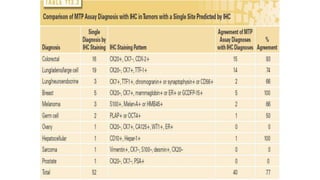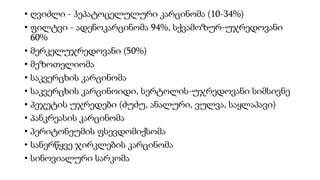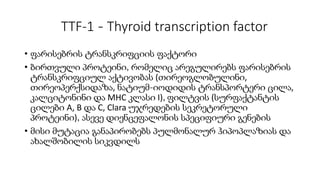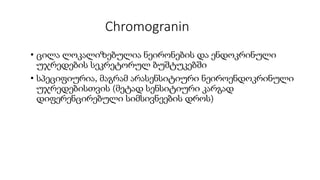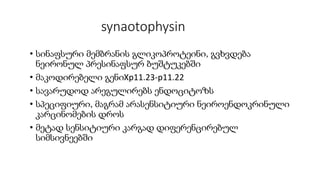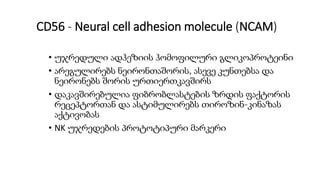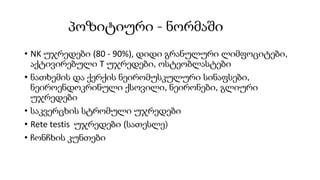бғЎбғҳбғӣбғЎбғҳбғ•бғңбғЈбғ бғҳ бғӣбғҗбғ бғҷбғ”бғ бғ”бғ‘бғҳ I
- 4. CK20 - бғӘбғҳбғўбғқбғҷбғ”бғ бғҗбғўбғҳбғң20 вҖў бғ”бғһбғҳбғ—бғ”бғҡбғЈбғ бғҳ бғӣбғҗбғ бғҷбғ”бғ бғҳ вҖў CK7-бғ—бғҗбғң бғЁбғ”бғ“бғҗбғ бғ”бғ‘бғҳбғ— бғңбғҗбғҷбғҡбғ”бғ‘бғҳ бғ”бғҘбғЎбғһбғ бғ”бғЎбғҳбғҗ
- 5. бғһбғқбғ–бғҳбғўбғҳбғЈбғ бғҳ - бғңбғқбғ бғӣбғҗбғЁбғҳ вҖў бғӣбғЎбғ®бғ•бғҳбғҡбғҳ бғңбғҗбғ¬бғҡбғҗбғ•бғҳ вҖў бғӣбғ”бғ бғҷбғ”бғҡбғҳбғЎ бғЈбғҜбғ бғ”бғ“бғ”бғ‘бғҳ вҖў бғ¬бғ•бғ бғҳбғҡбғҳ бғңбғҗбғ¬бғҡбғҗбғ•бғҳ вҖў бғЈбғ бғқбғ—бғ”бғҡбғҳбғЈбғӣбғҳ(бғҘбғқбғҡбғ’бғҳбғЎбғ”бғ‘бғ бғҳ бғЈбғҜбғ бғ”бғ“бғ”бғ‘бғҳ) вҖў бғЎбғҗбғЁбғ•бғҳбғҡбғқбғЎбғңбғқ
- 6. бғһбғқбғ–бғҳбғўбғҳбғЈбғ бғҳ - бғЎбғҳбғӣбғЎбғҳбғ•бғңбғ”бғ”бғ‘бғҳ вҖў бғЎбғ¬бғқбғ бғҳ бғңбғҗбғ¬бғҡбғҗбғ•бғҳ вҖў бғҗбғңбғҗбғҡбғЈбғ бғҳ вҖў бғҗбғһбғ”бғңбғ“бғҳбғҘбғЎбғҳбғЎ бғ”бғһбғҳбғ—бғ”бғҡбғЈбғ бғҳ бғңбғ”бғқбғһбғҡбғҗбғ–бғҳбғ”бғ‘бғҳ (100%) вҖў бғ‘бғҳбғҡбғҳбғҗбғ бғЈбғҡбғҳ бғһбғҗбғһбғҳбғҡбғҗбғ бғЈбғҡбғҳ бғЎбғҳбғӣбғЎбғҳбғ•бғңбғ”бғ”бғ‘бғҳ (бғҷбғ”бғ—бғҳбғҡбғ—бғ•бғҳбғЎбғ”бғ‘бғҳбғҗбғңбғҳ, бғҗбғ•бғ—бғ•бғҳбғЎбғ”бғ‘бғҳбғҗбғңбғҳ) вҖў бғӣбғЎбғ®бғ•бғҳбғҡбғҳ бғңбғҗбғ¬бғҡбғҗбғ•бғҳ вҖў бғҷбғЈбғӯбғҳбғЎ (18-31%) вҖў бғ°бғ”бғһбғҗбғўбғқбғӘбғ”бғҡбғЈбғҡбғЈбғ бғҳ (20%) вҖў бғ°бғ”бғһбғҗбғўбғқбғҳбғ“бғЈбғ бғҳ бғҗбғ“бғ”бғңбғЧЗғҷбғҗбғ бғӘбғҳбғңбғқбғӣбғҗ
- 7. вҖў бғӨбғҳбғҡбғўбғ•бғҳбғЎ бғӣбғЈбғӘбғҳбғңбғЈбғ бғҳ бғ‘бғ бғқбғңбғҘбғқбғҗбғҡбғ•бғ”бғқбғҡбғЈбғ бғҳ бғЎбғҳбғӣбғЎбғҳбғ•бғңбғ” вҖў бғӣбғ”бғ бғҷбғ”бғҡбғҳбғЎ бғЈбғҜбғ бғ”бғ“бғ”бғ‘бғҳ вҖў бғЎбғҗбғҷбғ•бғ”бғ бғӘбғ®бғҳбғЎ вҖў бғһбғ”бғҜбғ”бғўбғҳбғЎ бғ“бғҗбғҗбғ•бғҗбғ“бғ”бғ‘бғҗ(бғӣбғ”бғқбғ бғҗбғ“бғҳ) вҖў бғһбғҗбғңбғҷбғ бғ”бғҗбғЎбғҳбғЎ бғЎбғҗбғ“бғҳбғңбғ бғқбғ•бғҗбғңбғҳ вҖў бғһбғ бғқбғЎбғўбғҗбғўбғҳбғЎ бғҷбғҳбғ‘бғқ (бғ•бғҗбғ бғҳбғҗбғ‘бғ”бғҡбғЈбғ бғҳбғҗ) вҖў бғЎбғҳбғңбғқбғңбғҗбғ–бғҗбғҡбғЈбғ бғҳ бғҗбғ“бғ”бғңбғЧЗғҷбғҗбғ бғӘбғҳбғңбғқбғӣбғҗ(50%) вҖў бғ«бғҳбғ бғҳбғ—бғҗбғ“бғҳ бғЎбғҗбғңбғ”бғ бғ¬бғ§бғ•бғ” бғҜбғҳбғ бғҷбғ•бғҡбғ”бғ‘бғҳбғЎ бғ¬бғ•бғ бғҳбғҡбғЈбғҜбғ бғ”бғ“бғқбғ•бғҗбғңбғҳ бғЎбғҳбғӣбғЎбғҳбғ•бғңбғ” вҖў бғ•бғЈбғҡбғ•бғҗбғҡбғЈбғ бғҳ бғһбғ”бғҜбғ”бғўбғҳбғЎ бғ“бғҗбғҗбғ•бғҗбғ“бғ”бғ‘бғҗ (бғӣбғ”бғқбғ бғҗбғ“бғҳ бғЈбғ бғқбғ—бғ”бғҡбғҳбғҗбғҡбғЈбғ бғҳ бғҗбғң бғҗбғңбғқбғ бғ”бғҘбғўбғЈбғҡбғҳ бғҷбғҗбғ бғӘбғҳбғңбғқбғӣбғҳбғЎ бғ“бғ бғқбғЎ)
- 8. CK7 - бғӘбғҳбғўбғқбғҷбғ”бғ бғҗбғўбғҳбғң7 вҖў бғҗбғ бғҗбғҷбғ”бғ бғҗбғўбғҳбғңбғҳбғ–бғҳбғ бғ”бғ‘бғЈбғҡбғҳ бғ”бғһбғҳбғ—бғ”бғҡбғҳбғЈбғӣбғҳбғЎ бғҷбғ”бғ бғҗбғўбғҳбғңбғҳбғЎ бғўбғҳбғһбғҳ2 вҖў бғңбғҗбғңбғҗбғ®бғҳбғҗ бғ«бғЈбғ«бғЈбғЁбғҳ, бғЎбғҗбғҷбғ•бғ”бғ бғӘбғ®бғ”бғЁбғҳ бғ“бғҗ бғЈбғ бғқбғ—бғ”бғҡбғҳбғЈбғӣбғЁбғҳ
- 9. бғһбғқбғ–бғҳбғўбғҳбғЈбғ бғҳ - бғңбғқбғ бғӣбғҗбғЁбғҳ вҖў бғҗбғңбғҗбғҡбғЈбғ бғҳ бғҜбғҳбғ бғҷбғ•бғҡбғ”бғ‘бғҳ бғ“бғҗ бғ’бғҗбғ бғ“бғҗбғӣбғҗбғ•бғҗбғҡбғҳ бғ–бғқбғңбғҗ вҖў бғЎбғҗбғңбғҗбғҰбғ•бғҡбғ” бғ’бғ–бғ”бғ‘бғҳ вҖў бғ«бғЈбғ«бғЈ вҖў бғӘбғ”бғ бғ•бғҳбғҷбғҗбғҡбғЈбғ бғҳ бғҜбғҳбғ бғҷбғ•бғҡбғ”бғ‘бғҳ вҖў бғ”бғңбғ“бғқбғӣбғ”бғўбғ бғҳбғЈбғӣбғҳ вҖў бғӨбғҗбғҡбғқбғһбғҳбғЎ бғӣбғҳбғҡбғ”бғ‘бғҳ вҖў бғўбғ бғҗбғңбғЎбғӘбғ”бғ бғ•бғҳбғҷбғҗбғҡбғЈбғ бғҳ бғҡбғқбғ бғ¬бғқбғ•бғҗбғңбғҳ вҖў бғңбғҗбғҰбғ•бғҡбғҳбғЎ бғ‘бғЈбғЁбғўбғҳ
- 10. вҖў бғ—бғҳбғ бғҷбғӣбғҡбғҳбғЎ бғЁбғ”бғӣбғҷбғ бғ”бғ‘бғҳ бғӣбғҳбғҡбғҗбғҷбғ”бғ‘бғҳ вҖў бғӨбғҳбғҡбғўбғ•бғ”бғ‘бғҳ вҖў бғӣбғ”бғ–бғқбғ—бғ”бғҡбғҳбғЈбғӣбғҳ вҖў бғЎбғҗбғҷбғ•бғ”бғ бғӘбғ®бғҳбғЎ бғ”бғһбғҳбғ—бғ”бғҡбғҳбғЈбғӣбғҳ вҖў бғһбғҗбғңбғҷбғ бғ”бғҗбғЎбғҳбғЎ бғЎбғҗбғ“бғҳбғңбғҗбғ бғҳ вҖў бғҗбғӘбғҳбғңбғЈбғЎбғҳбғЎ бғЎбғҗбғңбғ”бғ бғ¬бғ§бғ•бғ” бғҜбғҳбғ бғҷбғ•бғҡбғ”бғ‘бғҳ вҖў бғӨбғҗбғ бғҳбғЎбғ”бғ‘бғ бғҳбғЎ бғ”бғһбғҳбғ—бғ”бғҡбғҳбғЈбғӣбғҳ вҖў бғҷбғҡбғҗбғ бғҷбғҳбғЎ бғЈбғҜбғ бғ”бғ“бғ”бғ‘бғҳ вҖў бғўбғ бғқбғӨбғқбғ‘бғҡбғҗбғЎбғўбғ”бғ‘бғҳ вҖў бғЈбғ бғқбғ—бғ”бғҡбғҳбғЈбғӣбғҳ
- 11. бғһбғқбғ–бғҳбғўбғҳбғЈбғ бғҳ - бғЎбғҳбғӣбғЎбғҳбғ•бғңбғ”бғ”бғ‘бғҳ вҖў бғҗбғ“бғ”бғңбғқбғҷбғҗбғ бғӘбғҳбғңбғқбғӣбғ”бғ‘бғҳ - бғЎбғ¬бғқбғ бғҳ бғңбғҗбғ¬бғҡбғҗбғ•бғҳбғЎ, бғӣбғЎбғ®бғ•бғҳбғҡбғҳ бғңбғҗбғ¬бғҡбғҗбғ•бғҳбғЎ, бғ¬бғ•бғ бғҳбғҡбғҳ бғңбғҗбғ¬бғҡбғҗбғ•бғҳбғЎ, бғ‘бғҳбғҡбғҳбғҗбғ бғЈбғҡбғҳ бғўбғ бғҗбғҘбғўбғҳбғЎ, бғңбғҗбғҰбғ•бғҡбғҳбғЎ бғ‘бғЈбғЁбғўбғҳбғЎ, бғЎбғҗбғ§бғҡбғҗбғһбғҗбғ•бғҳбғЎ, бғһбғҗбғңбғҷбғ бғ”бғҗбғЎбғҳбғЎ, бғҷбғЈбғӯбғҳбғЎ, бғЁбғҗбғ бғ“бғҳбғЎ бғ‘бғЈбғЁбғўбғҳбғЎ, бғӘбғ”бғ бғ•бғҳбғҷбғҗбғҡбғЈбғ бғҳ, бғ”бғңбғ“бғқбғӣбғ”бғўбғ бғҳбғЈбғҡбғҳ, бғЈбғ бғқбғ—бғ”бғҡбғЈбғ бғҳ. вҖў бғҗбғһбғ”бғңбғ“бғҳбғҘбғЎбғҳбғЎ бғ”бғһбғҳбғ—бғ”бғҡбғЈбғ бғҳ бғңбғ”бғқбғһбғҡбғҗбғ–бғҳбғ”бғ‘бғҳ вҖў бғ‘бғҗбғ–бғҗбғҡбғЈбғ бғҳ, бғЎбғҘбғ•бғҗбғӣбғқбғ–бғЈбғ бғЈбғҜбғ бғ”бғ“бғқбғ•бғҗбғңбғҳ бғҷбғҗбғ бғӘбғҳбғңбғқбғӣбғҗ бғ•бғҗбғҡбғ“бғ”бғҳбғ”бғ бғҳбғЎ бғЈбғҜбғ бғ”бғ“бғ”бғ‘бғҳбғ—. вҖў бғ«бғЈбғ«бғЈбғЎ бғҷбғҳбғ‘бғқ вҖў бғҷбғҗбғ бғӘбғҳбғңбғқбғҳбғ“бғҳ (бғ’бғҳ бғўбғ бғҗбғҘбғўбғҳбғЎ 11%) вҖў бғ’бғ”бғ бғӣбғҳбғңбғҗбғӘбғҳбғЈбғҡбғҳ бғЎбғҳбғӣбғЎбғҳбғ•бғңбғ”бғ”бғ‘бғҳ вҖў бғ—бғҳбғ бғҷбғӣбғ”бғҡбғҳ - бғ—бғҳбғ бғҷбғӣбғ”бғҡбғЈбғҜбғ бғ”бғ“бғқбғ•бғҗбғңбғҳ, бғңбғҗбғ—бғ”бғҡбғЈбғҜбғ бғ”бғ“бғқбғ•бғҗбғңбғҳ бғҷбғҳбғ‘бғқ, бғһбғҗбғһбғҳбғҡбғҗбғ бғЈбғҡбғҳ, бғЁбғ”бғӣбғҷбғ бғ”бғ‘бғҳ бғӣбғҳбғҡбғҗбғҷбғ”бғ‘бғҳбғЎ.
- 12. вҖў бғҰбғ•бғҳбғ«бғҡбғҳ - бғ°бғ”бғһбғҗбғўбғқбғӘбғ”бғҡбғЈбғҡбғЈбғ бғҳ бғҷбғҗбғ бғӘбғҳбғңбғқбғӣбғҗ (10-34%) вҖў бғӨбғҳбғҡбғўбғ•бғҳ - бғҗбғ“бғ”бғңбғЧЗғҷбғҗбғ бғӘбғҳбғңбғқбғӣбғҗ 94%, бғЎбғҘбғ•бғҗбғӣбғқбғ–бғЈбғ -бғЈбғҜбғ бғ”бғ“бғқбғ•бғҗбғңбғҳ 60% вҖў бғӣбғ”бғ бғҷбғ”бғҡбғЈбғҜбғ бғ”бғ“бғқбғ•бғҗбғңбғҳ (50%) вҖў бғӣбғ”бғ–бғқбғ—бғ”бғҡбғҳбғқбғӣбғҗ вҖў бғЎбғҗбғҷбғ•бғ”бғ бғӘбғ®бғҳбғЎ бғҷбғҗбғ бғӘбғҳбғңбғқбғӣбғҗ вҖў бғЎбғҗбғҷбғ•бғ”бғ бғӘбғ®бғҳбғЎ бғҷбғҗбғ бғӘбғҳбғңбғқбғҳбғ“бғҳ, бғЎбғ”бғ бғўбғқбғҡбғҳбғЎ-бғЈбғҜбғ бғ”бғ“бғқбғ•бғҗбғңбғҳ бғЎбғҳбғӣбғЎбғҳбғ•бғңбғ” вҖў бғһбғ”бғҜбғ”бғўбғҳбғЎ бғЈбғҜбғ бғ”бғ“бғ”бғ‘бғҳ (бғ«бғЈбғ«бғЈ, бғҗбғңбғҗбғҡбғЈбғ бғҳ, бғ•бғЈбғҡбғ•бғҗ, бғЎбғҗбғ§бғҡбғҗбғһбғҗбғ•бғҳ) вҖў бғһбғҗбғңбғҷбғ бғ”бғҗбғЎбғҳбғЎ бғҷбғҗбғ бғӘбғҳбғңбғқбғӣбғҗ вҖў бғһбғ”бғ бғҳбғўбғқбғңбғ”бғЈбғӣбғҳбғЎ бғӨбғЎбғ”бғ•бғ“бғқбғӣбғҳбғҘбғЎбғқбғӣбғҗ вҖў бғЎбғҗбғңбғ”бғ бғ¬бғ§бғ•бғ” бғҜбғҳбғ бғҷбғҡбғ”бғ‘бғҳбғЎ бғҷбғҗбғ бғӘбғҳбғңбғқбғӣбғҗ вҖў бғЎбғҳбғңбғқбғ•бғҳбғҗбғҡбғЈбғ бғҳ бғЎбғҗбғ бғҷбғқбғӣбғҗ
- 13. CDX-2 - Caudal-type homeobox вҖў бғңбғҗбғ¬бғҡбғҗбғ•бғЈбғ бғҳ бғЈбғҜбғ бғ”бғ“бғ”бғ‘бғҳбғЎ бғ‘бғҳбғ бғ—бғ•бғЈбғҡбғҳ бғўбғ бғҗбғңбғЎбғҷбғ бғҳбғӨбғӘбғҳбғЈбғҡбғҳ бғӨбғҗбғҘбғўбғқбғ бғҳбғЎ бғӣбғҗбғҷбғқбғ“бғҳбғ бғ”бғ‘бғ”бғҡбғҳ Homeobox бғ’бғ”бғңбғҳ вҖў бғЁбғ”бғ“бғҗбғ бғ”бғ‘бғҳбғ— бғЎбғһбғ”бғӘбғҳбғӨбғҳбғЈбғ бғҳбғҗ бғңбғҗбғ¬бғҡбғҗбғ•бғҳбғЎ бғ”бғһбғҳбғ—бғ”бғҡбғҳбғЈбғӣбғҳбғЎбғ—бғ•бғҳбғЎ;
- 14. бғһбғқбғ–бғҳбғўбғҳбғЈбғ бғҳ - бғңбғқбғ бғӣбғҗбғЁбғҳ вҖў бғңбғҗбғ¬бғҡбғҗбғ•бғЈбғ бғҳ бғ”бғһбғҳбғ—бғ”бғҡбғҳбғЈбғӣбғҳбғЎ бғҷбғ бғҳбғһбғўбғ”бғ‘бғҳбғЎ бғ“бғҗ бғ®бғҗбғқбғ”бғ‘бғҳбғЎ бғ‘бғҳбғ бғ—бғ•бғ”бғ‘бғҳ вҖў бғһбғҗбғңбғҷбғ бғ”бғҗбғЎбғҳбғЎ, бғҷбғЈбғӯбғҳбғЎ, бғЎбғҗбғ§бғҡбғҗбғһбғҗбғ•бғҳбғЎ бғ”бғһбғҳбғ—бғ”бғҡбғҳбғЈбғӣбғҳ
- 15. бғһбғқбғ–бғҳбғўбғҳбғЈбғ бғҳ - бғЎбғҳбғӣбғЎбғҳбғ•бғңбғ”бғ”бғ‘бғҳ вҖў бғЁбғҗбғ бғ“бғҳбғЎ бғ‘бғЈбғЁбғўбғҳбғЎ/бғЁбғҗбғ бғ“бғЎбғҗбғ“бғҳбғңбғҗбғ бғҳбғЎ бғҗбғ“бғ”бғңбғЧЗғҷбғҗбғ бғӘбғҳбғңбғқбғӣбғҗ, бғЈбғ бғқбғ—бғ”бғҡбғЈбғ бғҳ бғҷбғҗбғ бғӘбғҳбғңбғқбғӣбғҗ in situ; бғҳбғңбғўбғ”бғЎбғўбғҳбғңбғҗбғҡбғЈбғ бғҳ бғӣбғ”бғўбғҗбғһбғҡбғҗбғ–бғҳбғҗ, бғЁбғҗбғ бғ“бғЎбғҗбғ“бғҳбғңбғҗбғ бғҳбғЎ бғҗбғ бғҗбғҳбғңбғ•бғҗбғ–бғҳбғЈбғ бғҳ, бғӣбғЈбғӘбғҳбғңбғЈбғ бғҳ, бғӘбғҳбғЎбғўбғЈбғ бғҳ, бғЎбғҳбғӣбғЎбғҳбғ•бғңбғ”. вҖў бғ°бғҳбғһбғ”бғ бғһбғҡбғҗбғЎбғўбғҳбғЈбғ бғҳ бғһбғқбғҡбғҳбғһбғҳ, бғҷбғқбғҡбғқбғ бғ”бғҘбғўбғЈбғҡбғҳ бғҗбғ“бғ”бғңбғЧЗғҷбғҗбғ бғӘбғҳбғңбғқбғӣбғҗ вҖў бғ‘бғҗбғ бғ”бғўбғҳбғЎ бғЎбғҗбғ§бғҡбғҗбғһбғҗбғ•бғҳ - бғҳбғңбғўбғ”бғЎбғўбғҳбғңбғҗбғҡбғЈбғ бғҳ бғӣбғ”бғўбғҗбғһбғҡбғҗбғ–бғҳбғҗ; бғЎбғҗбғ§бғҡбғҗбғһбғҗбғ•бғҳбғЎ бғӘбғҳбғҡбғҳбғңбғ“бғ бғЈбғҡбғҳ бғ”бғһбғҳбғ—бғ”бғҡбғҳбғЈбғӣбғҳбғЎ бғӣбғ”бғўбғҗбғһбғҡбғҗбғ–бғҳбғҗ бғ’бғқбғ‘бғҡбғ”бғўбғҳбғЎ бғЈбғҜбғ бғ”бғ“бғ”бғ‘бғҳбғЎ бғ’бғҗбғ бғ”бғЁбғ” вҖў бғ”бғҘбғЎбғўбғ бғҗбғ°бғ”бғһбғҗбғўбғЈбғ бғҳ бғЎбғҗбғңбғҗбғҰбғ•бғҡбғ” бғ’бғ–бғ”бғ‘бғҳбғЎ бғҷбғҗбғ бғӘбғҳбғңбғқбғӣбғҗ
- 16. вҖў бғ¬бғ•бғ бғҳбғҡбғҳ бғңбғҗбғ¬бғҡбғҗбғ•бғҳбғЎ бғҷбғҗбғ бғӘбғҳбғңбғқбғӣбғҗ вҖў бғҷбғЈбғӯбғҳбғЎ бғҗбғ“бғ”бғңбғЧЗғҷбғҗбғ бғӘбғҳбғңбғқбғӣбғҗ (37-70%) вҖў бғӣбғЈбғӘбғҳбғңбғЈбғ бғҳ бғҗбғ“бғ”бғңбғқбғҷбғҗбғ бғӘбғҳбғңбғқбғӣбғ”бғ‘бғҳ - бғӨбғҳбғҡбғўбғ•бғҳбғЎ, бғЎбғҗбғҷбғ•бғ”бғ бғӘбғ®бғҳбғЎ вҖў бғ‘бғ”бғӯбғ“бғҳбғЎбғ”бғ‘бғЈбғ -бғЈбғҜбғ бғ”бғ“бғқбғ•бғҗбғңбғҳ бғҷбғҗбғ бғӘбғҳбғңбғқбғӣбғ”бғ‘бғҳ вҖў бғўбғ”бғ бғҗбғўбғқбғӣбғҗ - бғЎбғҗбғ—бғ”бғЎбғҡбғҳбғЎ бғӣбғ”бғўбғҗбғЎбғўбғҗбғ–бғЈбғ бғҳ (100%) вҖў бғ’бғҳ бғўбғ бғҗбғҘбғўбғҳбғЎ бғҷбғҗбғ бғӘбғҳбғңбғқбғҳбғ“бғҳ, бғңбғ”бғҳбғ бғқбғ”бғңбғ“бғқбғҷбғ бғҳбғңбғЈбғҡбғҳ бғЎбғҳбғӣбғЎбғҳбғ•бғңбғ”бғ”бғ‘бғҳ (бғҗбғһбғ”бғңбғ“бғҳбғҘбғЎбғҳ, бғ—бғ”бғ«бғқбғЎ бғңбғҗбғ¬бғҡбғҗбғ•бғҳ, бғһбғҗбғңбғҷбғ бғ”бғҗбғЎбғҳ)
- 18. TTF-1 - Thyroid transcription factor вҖў бғӨбғҗбғ бғҳбғЎбғ”бғ‘бғ бғҳбғЎ бғўбғ бғҗбғңбғЎбғҷбғ бғҳбғӨбғӘбғҳбғҳбғЎ бғӨбғҗбғҘбғўбғқбғ бғҳ вҖў бғ‘бғҳбғ бғ—бғ•бғЈбғҡбғҳ бғһбғ бғқбғўбғ”бғҳбғңбғҳ, бғ бғқбғӣбғ”бғҡбғҳбғӘ бғҗбғ бғ”бғ’бғЈбғҡбғҳбғ бғ”бғ‘бғЎ бғӨбғҗбғ бғҳбғЎбғ”бғ‘бғ бғҳбғЎ бғўбғ бғҗбғңбғЎбғҷбғ бғҳбғӨбғӘбғҳбғЈбғҡ бғҗбғҘбғўбғҳбғ•бғқбғ‘бғҗбғЎ (бғ—бғҳбғ бғ”бғқбғ’бғҡбғқбғ‘бғЈбғҡбғҳбғңбғҳ, бғ—бғҳбғ бғ”бғқбғһбғ”бғ бғҘбғЎбғҳбғ“бғҗбғ–бғҗ, бғңбғҗбғўбғҳбғЈбғӣ-бғҳбғқбғ“бғҳбғ“бғҳбғЎ бғўбғ бғҗбғңбғЎбғһбғқбғ бғўбғ”бғ бғҳ бғӘбғҳбғҡбғҗ, бғҷбғҗбғҡбғӘбғҳбғўбғқбғңбғҳбғңбғҳ бғ“бғҗ MHC бғҷбғҡбғҗбғЎбғҳ I), бғӨбғҳбғҡбғўбғ•бғҳбғЎ (бғЎбғЈбғ бғӨбғҗбғҘбғўбғҗбғңбғўбғҳбғЎ бғӘбғҳбғҡбғ”бғ‘бғҳ A, B бғ“бғҗ C, Clara бғЈбғҜбғ бғ”бғ“бғ”бғ‘бғҳбғЎ бғЎбғ”бғҷбғ бғ”бғўбғқбғ бғЈбғҡбғҳ бғһбғ бғқбғўбғ”бғҳбғңбғҳ), бғҗбғЎбғ”бғ•бғ” бғ“бғҳбғ”бғңбғӘбғ”бғӨбғҗбғҡбғқбғңбғҳбғЎ бғЎбғһбғ”бғӘбғҳбғӨбғҳбғЈбғ бғҳ бғ’бғ”бғңбғ”бғ‘бғҳбғЎ вҖў бғӣбғҳбғЎбғҳ бғӣбғЈбғўбғҗбғӘбғҳбғҗ бғ’бғҗбғңбғҗбғһбғҳбғ бғқбғ‘бғ”бғ‘бғЎ бғһбғЈбғҡбғӣбғқбғңбғҗбғҡбғЈбғ бғ°бғҳбғһбғқбғһбғҡбғҗбғ–бғҳбғҗбғЎ бғ“бғҗ бғҗбғ®бғҗбғҡбғЁбғқбғ‘бғҳбғҡбғҳбғЎ бғЎбғҳбғҷбғ•бғ“бғҳбғҡбғЎ
- 19. бғһбғқбғ–бғҳбғўбғҳбғЈбғ бғҳ - бғңбғқбғ бғӣбғҗбғЁбғҳ вҖў бғӨбғҳбғҡбғўбғ•бғҳбғЎ бғһбғңбғ”бғ•бғӣбғқбғӘбғҳбғўбғ”бғ‘бғҳ бғўбғҳбғһбғҳ 2 бғ“бғҗ Clara бғЈбғҜбғ бғ”бғ“бғ”бғ‘бғҳ вҖў бғӨбғҗбғ бғҳбғЎбғ”бғ‘бғ бғҳбғЎ бғӨбғқбғҡбғҳбғҷбғЈбғҡбғЈбғ бғҳ бғ“бғҗ бғһбғҗбғ бғҗбғӨбғқбғҡбғҳбғҷбғЈбғҡбғЈбғ бғҳ C бғЈбғҜбғ бғ”бғ“бғ”бғ‘бғҳ
- 20. бғһбғқбғ–бғҳбғўбғҳбғЈбғ бғҳ - бғЎбғҳбғӣбғЎбғҳбғ•бғңбғ”бғ”бғ‘бғҳ вҖў бғӨбғҳбғҡбғўбғ•бғҳбғЎ бғҷбғҗбғ бғӘбғҳбғңбғқбғӣбғҗ: бғ¬бғ•бғ бғҳбғҡбғЈбғҜбғ бғ”бғ“бғқбғ•бғҗбғңбғҳ(90%), бғҗбғ“бғ”бғңбғЧЗғҷбғҗбғ бғӘбғҳбғңбғқбғӣбғҗ(75%), бғӣбғЎбғ®бғ•бғҳбғҡбғЈбғҜбғ бғ”бғ“бғ”бғқбғ•бғҗбғңбғҳ(40%), бғЎбғҘбғ•бғҗбғӣбғқбғ–бғЈбғ бғЈбғҜбғ бғ”бғ“бғқбғ•бғҗбғңбғҳ(5%) вҖў бғӨбғҗбғ бғҳбғЎбғ”бғ‘бғ бғҳ: бғ°бғҳбғһбғ”бғ бғһбғҡбғҗбғЎбғўбғҳбғЈбғ бғҳ бғ“бғҗ бғңбғ”бғқбғһбғҡбғҗбғЎбғўбғҳбғЈбғ бғҳ бғҘбғЎбғқбғ•бғҳбғҡбғ”бғ‘бғҳ, бғҗбғ бғҗбғ“бғҳбғӨбғ”бғ бғ”бғңбғӘбғҳбғ бғ”бғ‘бғЈбғҡбғҳ бғҷбғҗбғ бғӘбғҳбғңбғқбғӣбғ”бғ‘бғҳ вҖў бғӨбғҳбғҡбғўбғ•бғҳбғЎ бғ“бғҗ бғЎбғ®бғ•бғҗ бғ¬бғ•бғ бғҳбғҡбғЈбғҜбғ бғ”бғ“бғқбғ•бғҗбғңбғҳ бғЎбғҳбғӣбғЎбғҳбғ•бғңбғ”бғ”бғ‘бғҳ вҖў бғҷбғқбғҡбғқбғ бғ”бғҘбғўбғЈбғҡбғҳ бғҷбғҗбғ бғӘбғҳбғңбғқбғӣбғ”бғ‘бғҳ вҖў бғЁбғҗбғ бғ“бғҳбғЎ бғ‘бғЈбғЁбғўбғҳбғЎ бғ¬бғ•бғ бғҳбғҡбғЈбғҜбғ бғ”бғ“бғқбғ•бғҗбғңбғҳ бғҷбғҗбғ бғӘбғҳбғңбғқбғӣбғҗ (39%)
- 21. бғӨбғҳбғҡбғўбғ•бғҳ/бғңбғ”бғҳбғ бғқбғ”бғңбғ“бғқбғҷбғ бғҳбғңбғЈбғҡбғҳ вҖў CK7+ вҖў TTF-1+ вҖў Chromogranin+ бғҗбғң synaotophysin+ бғҗбғң CD56+
- 22. Chromogranin вҖў бғӘбғҳбғҡбғҗ бғҡбғқбғҷбғҗбғҡбғҳбғ–бғ”бғ‘бғЈбғҡбғҳбғҗ бғңбғ”бғҳбғ бғқбғңбғ”бғ‘бғҳбғЎ бғ“бғҗ бғ”бғңбғ“бғқбғҷбғ бғҳбғңбғЈбғҡбғҳ бғЈбғҜбғ бғ”бғ“бғ”бғ‘бғҳбғЎ бғЎбғ”бғҷбғ бғ”бғўбғқбғ бғЈбғҡ бғ‘бғЈбғЁбғўбғЈбғҷбғ”бғ‘бғЁбғҳ вҖў бғЎбғһбғ”бғӘбғҳбғӨбғҳбғЈбғ бғҳбғҗ, бғӣбғҗбғ’бғ бғҗбғӣ бғҗбғ бғҗбғЎбғ”бғңбғЎбғҳбғўбғҳбғЈбғ бғҳ бғңбғ”бғҳбғ бғқбғ”бғңбғ“бғқбғҷбғ бғҳбғңбғЈбғҡбғҳ бғЈбғҜбғ бғ”бғ“бғ”бғ‘бғҳбғЎбғ—бғ•бғҳбғЎ (бғӣбғ”бғўбғҗбғ“ бғЎбғ”бғңбғЎбғҳбғўбғҳбғЈбғ бғҳ бғҷбғҗбғ бғ’бғҗбғ“ бғ“бғҳбғӨбғ”бғ бғ”бғңбғӘбғҳбғ бғ”бғ‘бғЈбғҡбғҳ бғЎбғҳбғӣбғЎбғҳбғ•бғңбғ”бғ”бғ‘бғҳбғЎ бғ“бғ бғқбғЎ)
- 23. бғһбғқбғ–бғҳбғўбғҳбғЈбғ бғҳ - бғңбғқбғ бғӣбғҗбғЁбғҳ вҖў бғ—бғҳбғ бғҷбғӣбғ”бғҡбғ–бғ”бғ“бғҗ бғҜбғҳбғ бғҷбғ•бғҡбғҳбғЎ бғўбғ•бғҳбғңбғқбғ•бғҗбғңбғҳ бғЁбғ бғҳбғЎ(бғҘбғ бғқбғӣбғҗбғӨбғҳбғңбғЈбғ бғҳ бғЈбғҜбғ бғ”бғ“бғ”бғ‘бғҳ) бғңбғ”бғҳбғ бғқбғ”бғңбғ“бғқбғҷбғ бғҳбғңбғЈбғҡбғҳ бғ“бғҗ бғ’бғҗбғңбғ’бғҡбғҳбғЈбғ бғҳ бғЈбғҜбғ бғ”бғ“бғ”бғ‘бғҳ вҖў бғ’бғЈбғҡбғҳбғЎ AV бғҷбғ•бғҗбғңбғ«бғҳ вҖў бғһбғҗбғңбғҷбғ бғ”бғҗбғЎбғҳ (бғҷбғЈбғңбғ«бғЈбғҡбғ”бғ‘бғҳ) вҖў бғӨбғҗбғ бғҳбғЎбғ”бғ‘бғ бғҗбғ®бғҡбғқ бғҜбғҳбғ бғҷбғ•бғҗбғҡбғҳ (chief cells) вҖў бғӨбғҗбғ бғҳбғЎбғ”бғ‘бғ бғҳ (C бғЈбғҜбғ бғ”бғ“бғ”бғ‘бғҳ) вҖў бғЎбғҗбғңбғҗбғҰбғ•бғҡбғ” бғЎбғҗбғ“бғҳбғңбғ бғ”бғ‘бғҳ вҖў бғһбғҗбғңбғҷбғ бғ”бғҗбғЎбғҳбғЎ бғҗбғӘбғҳбғңбғЈбғ бғҳ бғЈбғҜбғ бғ”бғ“бғ”бғ‘бғҳ
- 24. бғһбғқбғ–бғҳбғўбғҳбғЈбғ бғҳ - бғЎбғҳбғӣбғЎбғҳбғ•бғңбғ”бғ”бғ‘бғҳ вҖў бғңбғ”бғҳбғ бғқбғ”бғңбғ“бғқбғҷбғ бғҳбғңбғЈбғҡбғҳ бғ“бғҗ бғ’бғҗбғңбғ’бғҡбғҳбғЈбғ бғҳ бғЈбғҜбғ бғ”бғ“бғ”бғ‘бғҳбғЎбғ’бғҗбғң бғ¬бғҗбғ бғӣбғқбғҘбғӣбғңбғҳбғҡбғҳ бғЎбғҳбғӣбғЎбғҳбғ•бғңбғ”бғ”бғ‘бғҳ (бғҷбғҗбғ бғӘбғҳбғңбғқбғҳбғ“бғҳ, бғӨбғҳбғҡбғўбғ•бғҳбғЎ бғӣбғ”бғ бғҷбғ”бғҡбғҳбғЎ-бғЈбғҜбғ бғ”бғ“бғқбғ•бғҗбғңбғҳ бғҷбғҗбғ бғӘбғҳбғңбғқбғӣбғҗ, бғңбғ”бғҳбғ бғқбғ‘бғҡбғҗбғЎбғўбғқбғӣбғҗ, бғңбғ”бғҳбғ бғқбғ”бғңбғ“бғқбғҷбғ бғҳбғңбғЈбғҡбғҳ бғҷбғҗбғ бғӘбғҳбғңбғқбғӣбғҗ, бғ¬бғ•бғ бғҳбғҡбғЈбғҜбғ бғ”бғ“бғқбғ•бғҗбғңбғҳ бғҷбғҗбғ бғӘбғҳбғңбғқбғӣбғҗ) вҖў бғ“бғ”бғЎбғӣбғқбғһбғҡбғҗбғЎбғўбғЈбғ бғҳ бғ¬бғ•бғ бғҳбғҡбғЈбғҜбғ бғ”бғ“бғқбғ•бғҗбғңбғҳ бғЎбғҳбғӣбғЎбғҳбғ•бғңбғ”, бғЁбғЈбғҗ бғ§бғЈбғ бғҳбғЎ бғҗбғ“бғ”бғңбғқбғӣбғҗ, бғһбғҗбғ бғҗбғ—бғҳбғ бғ”бғқбғҳбғ“бғЈбғҡбғҳ бғӘбғҳбғЎбғўбғҗ, бғ°бғҳбғһбғқбғӨбғҳбғ–бғҳбғЎ бғҗбғ“бғ”бғңбғқбғӣбғҗ вҖў бғңбғҗбғ§бғқбғӨбғҳбғЎ бғўбғҳбғһбғҳбғЎ бғ‘бғ”бғ•бғ бғҳ бғЎбғҳбғӣбғЎбғҳбғ•бғңбғ” (бғ°бғ”бғһбғҗбғўбғқбғ‘бғҡбғҗбғЎбғўбғқбғӣбғҗ, бғӨбғҳбғҡбғўбғ•бғҳбғЎ бғҗбғ“бғ”бғңбғЧЗғҷбғҗбғ бғӘбғҳбғңбғқбғӣбғҗ)
- 25. synaotophysin вҖў бғЎбғҳбғңбғҗбғӨбғЎбғЈбғ бғҳ бғӣбғ”бғӣбғ‘бғ бғҗбғңбғҳбғЎ бғ’бғҡбғҳбғҷбғқбғһбғ бғқбғўбғ”бғҳбғңбғҳ, бғ’бғ•бғ®бғ•бғ“бғ”бғ‘бғҗ бғңбғ”бғҳбғ бғқбғңбғЈбғҡ бғһбғ бғ”бғЎбғҳбғңбғҗбғӨбғЎбғЈбғ бғ‘бғЈбғЁбғўбғЈбғҷбғ”бғ‘бғЁбғҳ вҖў бғӣбғҗбғҷбғқбғ“бғҳбғ бғ”бғ‘бғ”бғҡбғҳ бғ’бғ”бғңбғҳXp11.23-p11.22 вҖў бғЎбғҗбғ•бғҗбғ бғЈбғ“бғқбғ“ бғҗбғ бғ”бғ’бғЈбғҡбғҳбғ бғ”бғ‘бғЎ бғ”бғңбғ“бғқбғӘбғҳбғўбғқбғ–бғЎ вҖў бғЎбғһбғ”бғӘбғҳбғӨбғҳбғЈбғ бғҳ, бғӣбғҗбғ’бғ бғҗбғӣ бғҗбғ бғҗбғЎбғ”бғңбғЎбғҳбғўбғҳбғЈбғ бғҳ бғңбғ”бғҳбғ бғқбғ”бғңбғ“бғқбғҷбғ бғҳбғңбғЈбғҡбғҳ бғҷбғҗбғ бғӘбғҳбғңбғқбғӣбғ”бғ‘бғҳбғЎ бғ“бғ бғқбғЎ вҖў бғӣбғ”бғўбғҗбғ“ бғЎбғ”бғңбғЎбғҳбғўбғҳбғЈбғ бғҳ бғҷбғҗбғ бғ’бғҗбғ“ бғ“бғҳбғӨбғ”бғ бғ”бғңбғӘбғҳбғ бғ”бғ‘бғЈбғҡ бғЎбғҳбғӣбғЎбғҳбғ•бғңбғ”бғ”бғ‘бғЁбғҳ
- 26. бғһбғқбғ–бғҳбғўбғҳбғЈбғ бғҳ - бғңбғқбғ бғӣбғҗбғЁбғҳ вҖў бғ—бғҳбғ бғҷбғӣбғ”бғҡбғ–бғ”бғ“бғҗ бғҜбғҳбғ бғҷбғ•бғҡбғҳбғЎ бғўбғ•бғҳбғңбғқбғ•бғҗбғңбғҳ бғЁбғ бғ” вҖў бғңбғ”бғҳбғ бғқбғңбғ”бғ‘бғҳ вҖў бғңбғ”бғҳбғ бғқбғ”бғңбғ“бғқбғҷбғ бғҳбғңбғЈбғҡбғҳ бғЈбғҜбғ бғ”бғ“бғ”бғ‘бғҳ вҖў бғ”бғһбғҳбғӨбғҳбғ–бғҳ
- 27. бғһбғқбғ–бғҳбғўбғҳбғЈбғ бғҳ - бғЎбғҳбғӣбғЎбғҳбғ•бғңбғ”бғ”бғ‘бғҳ вҖў бғңбғ”бғҳбғ бғқбғ”бғңбғ“бғқбғҷбғ бғҳбғңбғЈбғҡбғҳ бғЎбғҳбғӣбғЎбғҳбғ•бғңбғ”бғ”бғ‘бғҳ вҖў бғҗбғ“бғ бғ”бғңбғқбғҷбғқбғ бғўбғҳбғҷбғҗбғҡбғЈбғ бғҳ бғҗбғ“бғ”бғңбғқбғӣбғҗ бғ“бғҗ бғҷбғҗбғ бғӘбғҳбғңбғқбғӣбғҗ, бғңбғ”бғҳбғ бғқбғ‘бғҡбғҗбғЎбғўбғқбғӣбғҗ, бғқбғңбғҷбғқбғӘбғҳбғўбғқбғӣбғҗ, бғӨбғ”бғқбғҘбғ бғқбғӣбғқбғӘбғҳбғўбғқбғӣбғҗ вҖў бғӘбғ”бғңбғўбғ бғҗбғҡбғЈбғ бғҳ бғңбғ”бғҳбғ бғқбғӘбғҳбғўбғқбғӣбғҗ, бғ’бғҗбғңбғ’бғҡбғҳбғқбғӘбғҳбғўбғЈбғ бғҳ бғһбғҗбғ бғҗбғ’бғҗбғңбғ’бғҡбғҳбғқбғӣбғҗ, бғ’бғҗбғңбғ’бғҡбғҳбғқбғңбғ”бғҳбғ бғқбғӣбғҗ, бғһбғҡбғ”бғқбғӣбғқбғ бғӨбғЈбғҡбғҳ бғҘбғЎбғҗбғңбғ—бғқбғҗбғЎбғўбғ бғқбғӘбғҳбғўбғқбғӣбғҗ, бғ бғ”бғўбғҳбғңбғқбғ‘бғҡбғҗбғЎбғўбғқбғӣбғҗ вҖў бғӨбғҳбғҡбғўбғ•бғҳбғЎ бғӨбғ”бғўбғҗбғҡбғЈбғ бғҳ бғўбғҳбғһбғҳбғЎ, бғҷбғҗбғ бғ’бғҗбғ“ бғ“бғҳбғӨбғ”бғ бғ”бғңбғӘбғҳбғ бғ”бғ‘бғЈбғҡбғҳ бғҗбғ“бғ”бғңбғЧЗғҷбғҗбғ бғӘбғҳбғңбғқбғӣбғҗ вҖў бғ“бғ”бғЎбғӣбғқбғһбғҡбғҗбғЎбғўбғЈбғ бғҳ, бғ¬бғ•бғ бғҳбғҡбғЈбғҜбғ бғ”бғ“бғқбғ•бғҗбғңбғҳ бғЎбғҳбғӣбғЎбғҳбғ•бғңбғ”; бғһбғҗбғ бғҗбғ’бғҗбғңбғ’бғҡбғҳбғЈбғ бғҳ бғЎбғҳбғӣбғЎбғҳбғ•бғңбғ”; бғӨбғҗбғ бғҳбғЎбғ”бғ‘бғ бғҳбғЎ бғӣбғ”бғ“бғЈбғҡбғЈбғ бғҳ бғҷбғҗбғ бғӘбғҳбғңбғқбғӣбғҗ; бғӣбғ”бғ бғҷбғ”бғҡ-бғЈбғҜбғ бғ”бғ“бғқбғ•бғҗбғңбғҳ бғҷбғҗбғ бғӘбғҳбғңбғқбғӣбғҗ; бғӣбғҳбғҘбғЎбғқбғҳбғ“бғЈбғ бғҳ бғҘбғқбғңбғ“бғ бғқбғЎбғҗбғ бғҷбғқбғӣбғҗ; бғ—бғҳбғӣбғЈбғЎбғҳбғЎ бғһбғҗбғ бғҗбғ—бғҳбғ бғ”бғқбғҳбғ“бғЈбғҡбғҳ бғҷбғҗбғ бғӘбғҳбғңбғқбғӣбғҗ
- 28. CD56 - Neural cell adhesion molecule (NCAM) вҖў бғЈбғҜбғ бғ”бғ“бғЈбғҡбғҳ бғҗбғ“бғ°бғ”бғ–бғҳбғҳбғЎ бғ°бғқбғӣбғқбғӨбғҳбғҡбғЈбғ бғҳ бғ’бғҡбғҳбғҷбғқбғһбғ бғқбғўбғ”бғҳбғңбғҳ вҖў бғҗбғ бғ”бғ’бғЈбғҡбғҳбғ бғ”бғ‘бғЎ бғңбғ”бғҳбғ бғқбғңбғ—бғҗбғЁбғқбғ бғҳбғЎ, бғҗбғЎбғ”бғ•бғ” бғҷбғЈбғңбғ—бғ”бғ‘бғЎбғҗ бғ“бғҗ бғңбғ”бғҳбғ бғқбғңбғ”бғ‘бғЎ бғЁбғқбғ бғҳбғЎ бғЈбғ бғ—бғҳбғ”бғ бғ—бғҷбғҗбғ•бғЁбғҳбғ бғЎ вҖў бғ“бғҗбғҷбғҗбғ•бғЁбғҳбғ бғ”бғ‘бғЈбғҡбғҳбғҗ бғӨбғҳбғ‘бғ бғқбғ‘бғҡбғҗбғЎбғўбғ”бғ‘бғҳбғЎ бғ–бғ бғ“бғҳбғЎ бғӨбғҗбғҘбғўбғқбғ бғҳбғЎ бғ бғ”бғӘбғ”бғһбғўбғқбғ бғ—бғҗбғң бғ“бғҗ бғҗбғЎбғўбғҳбғӣбғЈбғҡбғҳбғ бғ”бғ‘бғЎ бғ—бғҳбғ бғқбғ–бғҳбғң-бғҷбғҳбғңбғҗбғ–бғҗбғЎ бғҗбғҘбғўбғҳбғ•бғқбғ‘бғҗбғЎ вҖў NK бғЈбғҜбғ бғ”бғ“бғ”бғ‘бғҳбғЎ бғһбғ бғқбғўбғқбғўбғҳбғһбғЈбғ бғҳ бғӣбғҗбғ бғҷбғ”бғ бғҳ
- 29. бғһбғқбғ–бғҳбғўбғҳбғЈбғ бғҳ - бғңбғқбғ бғӣбғҗбғЁбғҳ вҖў NK бғЈбғҜбғ бғ”бғ“бғ”бғ‘бғҳ (80 - 90%), бғ“бғҳбғ“бғҳ бғ’бғ бғҗбғңбғЈбғҡбғЈбғ бғҳ бғҡбғҳбғӣбғӨбғқбғӘбғҳбғўбғ”бғ‘бғҳ, бғҗбғҘбғўбғҳбғ•бғҳбғ бғ”бғ‘бғЈбғҡбғҳ T бғЈбғҜбғ бғ”бғ“бғ”бғ‘бғҳ, бғқбғЎбғўбғ”бғқбғ‘бғҡбғҗбғЎбғўбғ”бғ‘бғҳ вҖў бғңбғҗбғ—бғ®бғ”бғӣбғҳбғЎ бғ“бғҗ бғҘбғ”бғ бғҘбғҳбғЎ бғңбғ”бғҳбғ бғқбғӣбғЈбғЎбғҷбғЈбғҡбғЈбғ бғҳ бғЎбғҳбғңбғҗбғӨбғЎбғ”бғ‘бғҳ, бғңбғ”бғҳбғ бғқбғ”бғңбғ“бғқбғҷбғ бғҳбғңбғЈбғҡбғҳ бғҘбғЎбғқбғ•бғҳбғҡбғҳ, бғңбғ”бғҳбғ бғқбғңбғ”бғ‘бғҳ, бғ’бғҡбғҳбғЈбғ бғҳ бғЈбғҜбғ бғ”бғ“бғ”бғ‘бғҳ вҖў бғЎбғҗбғҷбғ•бғ”бғ бғӘбғ®бғҳбғЎ бғЎбғўбғ бғқбғӣбғЈбғҡбғҳ бғЈбғҜбғ бғ”бғ“бғ”бғ‘бғҳ вҖў Rete testis бғЈбғҜбғ бғ”бғ“бғ”бғ‘бғҳ (бғЎбғҗбғ—бғ”бғЎбғҡбғ”) вҖў бғ©бғқбғңбғ©бғ®бғҳбғЎ бғҷбғЈбғңбғ—бғ”бғ‘бғҳ
- 30. бғһбғқбғ–бғҳбғўбғҳбғЈбғ бғҳ - бғ°бғ”бғӣбғқбғһбғқбғ”бғ–бғЈбғ бғҳ бғ“бғҗбғ бғҰбғ•бғ”бғ•бғ”бғ‘бғҳ вҖў бғӣбғ¬бғ•бғҗбғ•бғ” бғӣбғҳбғ”бғҡбғқбғ“бғҳбғЈбғ бғҳ бғҡбғ”бғҳбғҷбғ”бғӣбғҳбғҗ вҖў бғҘбғ бғқбғңбғҳбғҷбғЈбғҡбғҳ бғӣбғҳбғ”бғҡбғқбғӣбғқбғңбғқбғӘбғҳбғўбғЈбғ бғҳ бғҡбғ”бғҳбғҷбғ”бғӣбғҳбғҗ вҖў бғҷбғҗбғңбғҳбғЎ бғҡбғҳбғӣбғӨбғқбғһбғ бғқбғҡбғҳбғӨбғ”бғ бғҗбғӘбғҳбғЈбғҡбғҳ бғ“бғҗбғ бғҰбғ•бғ”бғ•бғ”бғ‘бғҳ вҖў T бғЈбғҜбғ бғ”бғ“бғЈбғҡ бғҡбғҳбғӣбғӨбғқбғӣбғҗбғЎбғ—бғҗбғң бғ“бғҗбғҷбғҗбғ•бғЁбғҳбғ бғ”бғ‘бғЈбғҡбғҳ бғ”бғңбғўбғ”бғ бғқбғһбғҗбғ—бғҳбғҗ вҖў бғӣбғҳбғ”бғҡбғқбғҳбғ“бғЈбғ бғҳ бғЎбғҗбғ бғҷбғқбғӣбғҗ вҖў бғӣбғҳбғ”бғҡбғқбғӨбғҳбғ‘бғ бғқбғ–бғҳ вҖў бғӣбғҳбғ”бғҡбғқбғӣбғҗ, NK/T бғЈбғҜбғ бғ”бғ“бғЈбғҡбғҳ бғҡбғҳбғӣбғӨбғқбғӣбғҗ вҖў бғ‘бғҗбғ•бғЁбғ•бғ—бғҗ бғҗбғЎбғҗбғҷбғҳбғЎ бғҗбғңбғҗбғһбғҡбғҗбғ–бғҳбғЈбғ бғҳ бғ“бғҳбғ“бғЈбғҜбғ бғ”бғ“бғқбғ•бғҗбғңбғҳ бғҡбғҳбғӣбғӨбғқбғӣбғҗ вҖў бғҷбғҗбғңбғҳбғЎ бғһбғҳбғ бғ•бғ”бғҡбғҗбғ“бғҳ бғ’бғҗбғӣбғҗ-бғ“бғ”бғҡбғўбғҗ T-бғЈбғҜбғ бғ”бғ“бғқбғ•бғҗбғңбғҳ бғҡбғҳбғӣбғӨбғқбғӣбғҗ
- 31. бғЎбғ®бғ•бғҗ бғ“бғҗбғҗбғ•бғҗбғ“бғ”бғ‘бғ”бғ‘бғҳ вҖў бғҗбғҡбғ•бғ”бғқбғҡбғЈбғ бғҳ бғ бғҗбғ‘бғ“бғқбғӣбғҳбғқбғЎбғҗбғ бғҷбғқбғӣбғҗ вҖў бғӣбғ”бғңбғҳбғңбғ’бғҳбғқбғӣбғ”бғ‘бғҳ бғ“бғҗ бғӨбғҳбғҡбғўбғ•бғҳбғЎ бғӣбғ”бғңбғҳбғңбғ’бғқбғ”бғһбғҳбғ—бғ”бғҡбғЈбғ бғҳ бғҷбғ•бғҗбғңбғ«бғ”бғ‘бғҳ вҖў бғҳбғңбғўбғ бғҗбғ°бғ”бғһбғҗбғўбғЈбғ бғҳ бғңбғҗбғ—бғ”бғҡбғЈбғҜбғ бғ”бғ“бғқбғ•бғҗбғңбғҳ бғҘбғқбғҡбғҗбғңбғ’бғҳбғқбғҷбғҗбғ бғӘбғҳбғңбғқбғӣбғҗ вҖў бғӣбғ”бғ бғҷбғ”бғҡбғҳбғЎ бғЈбғҜбғ бғ”бғ“бғқбғ•бғҗбғңбғҳ бғЎбғҳбғӣбғЎбғҳбғ•бғңбғ” вҖў бғӣбғ”бғ–бғқбғ—бғ”бғҡбғҳбғқбғӣбғҗ вҖў бғңбғ”бғҳбғ бғқбғ‘бғҡбғҗбғЎбғўбғқбғӣбғҗ
- 32. вҖў бғңбғ”бғҳбғ бғқбғ”бғңбғ“бғқбғҷбғ бғҳбғңбғЈбғҡбғҳ бғҷбғҗбғ бғӘбғҳбғңбғқбғӣбғ”бғ‘бғҳ вҖў бғЎбғҗбғҷбғ•бғ”бғ бғӘбғ®бғҳбғЎ бғӨбғҳбғ‘бғ бғқбғӣбғҗ, бғӨбғҳбғ‘бғ бғқбғ—бғ”бғҷбғқбғӣбғҗ, бғҡбғ”бғҳбғқбғӣбғҳбғқбғӣбғҗ вҖў бғӨбғ”бғқбғҘбғ бғқбғӣбғқбғӘбғҳбғўбғқбғӣбғҗ вҖў бғӘбғ”бғ бғ•бғҳбғҘбғЎбғҳбғЎ бғ¬бғ•бғ бғҳбғЈбғҜбғ бғ”бғ“бғқбғ•бғҗбғңбғҳ бғҷбғҗбғ бғӘбғҳбғңбғқбғӣбғҗ вҖў бғЎбғҳбғңбғқбғ•бғҳбғҗбғҡбғЈбғ бғҳ бғЎбғҗбғ бғҷбғқбғӣбғҗ вҖў бғӨбғҗбғ бғҳбғЎбғ”бғ‘бғ бғҳ бғЎбғҳбғӣбғЎбғҳбғ•бғңбғ”бғ”бғ‘бғҳ вҖў бғЎбғҗбғЁбғ•бғҳбғҡбғқбғЎбғңбғқбғЎ бғһбғҡбғ”бғҘбғЎбғҳбғӨбғқбғ бғӣбғЈбғҡбғҳ бғЎбғҳбғӣбғЎбғҳбғ•бғңбғ” вҖў бғ•бғҳбғҡбғӣбғЎбғҳбғЎ бғЎбғҳбғӣбғЎбғҳбғ•бғңбғ”


